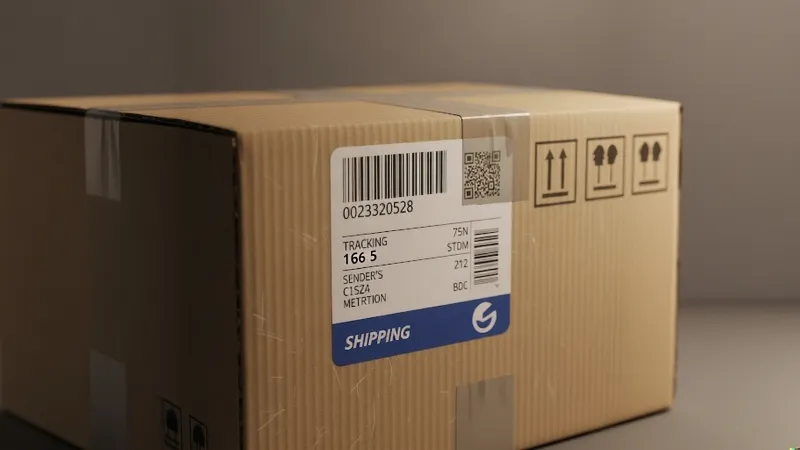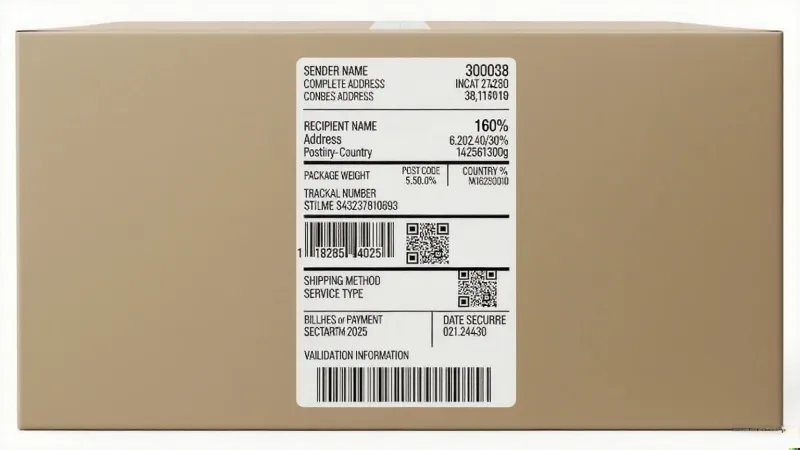
Almost all packages need a shipping label before shipping. A shipping label tells carriers important details. It shows the right address and tracking information. This helps them deliver the package. There are rare exceptions to this rule. Sometimes, hand-delivered or very local packages do not need labels. Problems can happen if labels are missing or hard to read. Wrong addresses or missing paperwork also cause issues. People can stop these problems by checking each label. A clear shipping label helps every package arrive safely.
Key Takeaways
Most packages need a clear shipping label. The label must have the right sender and receiver details. This helps make sure the package gets delivered safely. Put the label on a flat and easy-to-see spot. It should go on the biggest side of the package. Use the right size label and strong materials to keep it safe. Printed labels with barcodes are best for scanning. Handwritten labels can slow things down or cause mistakes. Some local or hand-delivered packages do not need labels. But most carriers want labels for tracking and delivery. Special shipments like hazardous materials need extra labels. International packages also need more labels and papers to follow strict rules.
Shipping Label Requirements

Essential Information
A shipping label has important details for carriers. Carriers like USPS, FedEx, and UPS have strict rules for labels. These rules help every package move without problems. The main things on a shipping label are:
Sender Name & Address: This tells where the package started. If the package cannot be delivered, it goes back to this address.
Recipient Name & Address: This shows where the package should go.
Package Weight and Dimensions: Carriers use this to figure out shipping costs and how to handle the package.
Tracking Number: This special code lets people check where the package is.
Barcodes and Unidirectional Codes: Machines use these codes to scan and sort packages fast.
Postal Code and Country: These help the package get to the right place.
Shipping Method and Service Type: This says if the package is standard, express, or priority.
Billing or Payment Information: This tells who pays for shipping.
Date and Validation Information: This shows when the package ships and that the label is good.
If shipping information is wrong or missing, big problems can happen. Packages might get lost, sent back, or take too long. Mistakes like typos, missing addresses, or wrong barcodes can stop deliveries and make customers upset. Carriers need correct shipping labels to keep everything working well.
Placement and Size
Where you put the shipping label and its size matter a lot. Carriers have clear rules for putting labels on packages:
Put the label on a flat spot, not on corners or edges.
Stick the label on the biggest side, usually the top.
Make sure the label is easy to see and not covered.
Keep the label straight with the longest side of the box.
Do not put the label on the bottom, where it can get ruined or missed.
If you use an old box, take off or cover all old shipping labels so there is no mix-up.
Label Size | Typical Use Case | Carrier Compatibility & Notes |
|---|---|---|
4″ x 6″ | Standard shipping label for most packages | Fits all required carrier information; standard for most carriers |
4″ x 8″ | Extra space for barcodes or handling instructions | Used for packages needing more details |
4″ x 4.25″ | Small parcels like electronics or jewelry | Suitable for small boxes with limited information |
6″ x 9″ | Large or international shipments | Used when extra customs or handling details are needed |
Larger sizes | Bulk shipments or detailed inventory listings | Used for multiple labels or extra information |
A 4″ x 6″ label works for most packages and most carriers. Bigger labels are better for international shipping or when you need more space.
Tip: Use strong label materials like polypropylene or polyester for packages that might get wet, hot, or handled roughly. Thermal transfer printing makes labels last longer than direct thermal printing. Always print labels in English for shipping in the United States.
Barcodes must be easy to scan. Leave empty space around the barcode with no words or pictures. This helps scanners read the code without mistakes. Carriers check barcode quality with strict rules. A bad or broken barcode can stop a package from moving.
Before you send a package, make sure the label is safe, easy to read, and has all the needed details. Cover the label with clear tape or a plastic pouch, but keep the barcode easy to scan. Do not use inkjet printers for lots of labels because the ink can smear. Always check the label before shipping to avoid delays or lost packages.
If you do not remove old shipping labels from reused boxes, the carrier might not accept the package. Old labels can confuse sorting machines and send the package to the wrong place. Always take off or cover old labels before putting on a new shipping label.
Package Exceptions

Rare Cases
Most shipping carriers want every package to have a shipping label. But there are a few times when you do not need one. If you give a package straight to someone, you do not need a label. This can happen with gifts or things you hand over in person. Some small businesses bring products to local buyers themselves. In these cases, they skip the label because the carrier does not handle the delivery.
Note: Carriers like USPS, FedEx, and UPS have strict rules. They will not take packages without a shipping label. If there is no label, the carrier cannot track or deliver the package.
Some local mail services or small courier companies let people use handwritten notes instead of a shipping label. These special cases are not common. Most packages still need a label to meet shipping rules and make sure they arrive safely.
Local Deliveries
Sometimes, local deliveries do not need a shipping label. For example, a bakery might bring cakes to nearby customers using its own drivers. The driver knows where to go and does not need a label. Some schools or clubs also give packages to members without a shipping carrier. In these cases, the sender and receiver know each other, so a label is not needed.
But if a local delivery uses a third-party shipping service, the package must have a shipping label. Carriers need the label to process, track, and deliver the package. The label has all the details needed for the carrier’s system.
Local deliveries without a shipping label only work in special cases:
The sender gives the package in person.
The delivery stays close by.
The sender and receiver know each other.
Tip: Always check the carrier’s rules before sending a package. Most carriers will not take packages without a shipping label, even for short trips.
Packages that go outside the local area or use a shipping company must follow all label rules. This helps stop lost packages and makes shipping go smoothly.
Generate a Shipping Label
Step-by-Step Guide
A lot of people use online tools or carrier websites to make a shipping label. These tools help you create, print, and put labels on packages. You can use them for one package or many at once. Here is an easy guide:
Pick a shipping carrier like USPS, UPS, or FedEx.
Pack your box well and check its weight and size.
Visit the carrier’s website or use shipping software.
Type in the sender and receiver addresses, package info, and choose the shipping method.
Make a shipping label and print it with a thermal or laser printer.
Stick the label on the biggest, flattest part of the box.
Add extra papers if needed, like customs forms for shipping to other countries.
Check all the details to make sure they are right and easy to read.
Use the tracking number to follow your package.
Many companies use shipping software for more options. The table below shows some popular tools:
Tool | Multi-Carrier Support | Bulk Label Printing | E-commerce Integration | Automation & Returns | Pricing Highlights |
|---|---|---|---|---|---|
Shippo | Yes (40+ carriers) | Yes | Yes | Yes | Free, Pro ($19/mo) |
ShippingEasy | Yes | Yes | Yes | Yes | Free, Growth ($19.99/mo) |
Easyship | Yes (250+ couriers) | Yes | Yes | Yes | Free, Plus ($29/mo) |
ShipStation | Yes | Yes | Yes | Yes | Free, Starter ($9.99/mo) |
These tools let you print many labels at once, check prices, and handle returns. They also work with online stores to make shipping simple.
Handwritten vs. Printed
Most carriers want printed labels on every package. Printed labels are easier for people and machines to read. They also look neat and professional. Handwritten labels might be okay for local or small deliveries, but they can cause trouble. Machines may not read handwriting, which can slow down shipping.
Tip: Always use a good printer and strong label paper. Put the label on a clean, dry spot. Do not put it on seams or edges. Cover the label with clear tape or a pouch, but keep the barcode easy to see.
Some common mistakes are using the wrong label size, leaving out information, or putting the label in the wrong place. Always check your label before you ship. Use weatherproof labels if your package might get wet.
Packages: Special Cases
Hazardous Materials
When you ship hazardous materials, you must follow strict rules. The United States Department of Transportation (DOT) makes these rules. You have to mark, label, and put placards on these packages. Each package needs the right shipping name and ID number in clear English. The label must show the hazard class, like flammable liquids or corrosives. Placards go on vehicles that carry these dangerous packages. The DOT also says each package must pass tests, like drop and leakproofness tests. Packages need UN symbols and codes to prove they are safe.
Regulatory Aspect | Description |
|---|---|
US DOT Marking Requirements | Packages must show the shipping name and ID number in English, visible and not covered. |
Labeling Requirements | Each package must have labels for its hazard class. |
Placarding Requirements | Vehicles with hazardous packages must display placards on all sides. |
Performance Testing | Packages must pass drop, leakproofness, and pressure tests. |
International Standards | GHS and UN rules set global label and symbol standards. |
If you ship dangerous goods without the right labels, you can get a big fine. Fines can be over $80,000 for each mistake every day. If someone gets hurt or something is damaged, the fine goes up. Workers must get special training too. USPS and other carriers will not take a hazardous package without the right shipping label and hazard markings.
International Shipments
Shipping packages to other countries has extra rules. Customs needs more than just a shipping label. Each package must have papers like a commercial invoice, air waybill, and sometimes a certificate of origin. These papers list the sender, receiver, value, weight, and what is inside. Customs uses this to check the package and figure out taxes.
Commercial Invoice: Lists sender, receiver, value, and product details.
Air Waybill: Works like a passport for the package in air shipping.
Certificate of Origin: Shows where the goods were made.
Export Licenses: Needed for restricted items.
Labels on international packages must match the papers. If details are wrong or missing, customs can hold the package. Common mistakes are missing product details, wrong codes, or not enough receiver information. Every country has its own label rules. The United States wants clear product and origin details. The European Union asks for lot numbers and stickers for the responsible party. Some Asian countries need special certificates. Good shipping labels help packages move across borders without problems or delays.
Most packages need a shipping label so they arrive on time. Carriers want the label to be clear and in the right spot. This helps stop delays or lost packages. Before you send a package, use this easy checklist:
Use strong materials and keep the label safe from harm.
Check everything again to be sure it is correct.
Getting your package ready the right way helps it get where it needs to go without trouble.
FAQ
Do all carriers require a shipping label?
Most carriers, like USPS, FedEx, and UPS, want a shipping label on every package. The label helps the carrier track and deliver it. If there is no label, the carrier might not take the package.
Can someone handwrite a shipping label?
Some local deliveries let people use handwritten labels. Big carriers like printed labels because machines read them better. Handwriting can slow things down or cause mistakes when sorting.
What happens if a shipping label is damaged?
Damaged labels can cause serious trouble. Carriers might not scan the barcode. The package could get lost or arrive late. Always cover the label with clear tape or put it in a pouch.
Which information must appear on a shipping label?
Required Item | Purpose |
|---|---|
Sender Address | For returns and tracking |
Recipient Address | Shows where to deliver |
Tracking Number | Lets you watch the package |
Helps sort the package fast |
If any of these are missing, the package might not get delivered.
